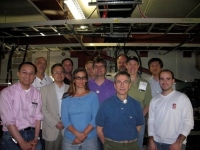 |
 |
|||||||||||||
|
|||||||||||||
|
|||||||||||||
|
When the Accelerator Test Facility (ATF) group at KEK decided to upgrade their beam position monitor system in 2005, Marc Ross had a solution. Based at SLAC at the time, he was a longtime collaborator with KEK and familiar with the instrumentation systems used throughout Fermilabís accelerator complex. In 2006, Ross became the head of Fermilabís Technical Division and could see how to continue his initiated beam position monitor upgrade efforts at the ATF damping ring. Called Echotek boards, these digital signal processing based systems offer a higher resolution potential Ė a characteristic that allows physicists to see more details about the beam. As it turned out, Fermilab was willing to make several Echotek boards available for testing the ATF system. Hence a new collaboration was born. “The collaboration between Fermilab, SLAC and KEK is absolutely good, and preliminary results are excellent,” says KEK's Junji Urakawa, the spokesperson for the ATF international collaboration. In operation since 1997, the ATF is a unique test facility for establishing the feasibility of producing and controlling the ultra-low emittance beams that are required for linear colliders. Capable of producing electron beams that will be similar to the ones in the ILC, the circular ring of KEK's test facility squeezes the beam down to make it extremely thin. For the ILC, the thinner the beam, or lower the emittance, the more particle collisions occur in the detectors and that makes everyone happy. In order to achieve this ultra low emitance, the beam optics must be controlled with a high degree of precision, which require a very precise understanding of the beam's position within the damping ring magnets. Like global positioning systems inside the accelerator, the beam position monitors in the ILC will require an extremely high resolution of less than one micron. While the physical beam position monitor pickups in the ATF were already similar to the design that will be used in the ILC, their readout systems required an upgrade to meet the resolution requirements, which is where the Echotek based system comes in. In February 2007, a team of six scientists from Fermilab joined SLAC to install the first eight Echotek boards in the ATF. “Most of our effort wasn't hardware but rather the software, which had to be written almost from scratch,” says Fermilab's Manfred Wendt. In May 2007, the teams from Fermilab and SLAC returned and installed 12 more boards. The collaboration members are still analysing the data, but preliminary results demonstrate a resolution in the 200 to 400 nanometre range - a factor of almost thirty better than the old readout systems which had a resolution of approximately 10 microns (10000 nanometres). “We are still working toward a beam position monitor resolution goal of 100 nanometres,” says SLAC's Tonee Smith. With 20 boards installed so far, the collaboration intends to install approximately 40 more over the next several months. “We plan to upgrade as much of the ring as possible given time and budget constraints,” Smith says. Fermilab and SLAC will most likely take their next trip to KEK this autumn, and in the meantime will continue analysing the data they collected. “This is a collaboration with real practical results,” says Wendt. Smith agrees that the collaboration among the three labs is a good example for the future. “The greater number of labs that you can bring into the project, the more feasible the ILC collaboration is as a whole,” she says. Even though SLAC and KEK have closely collaborated on ATF activities for several years now, Smith says that the Fermilab team didn't have any trouble fitting in as the new kid on the block. “It is a great fit, collaboration-wise, and it is very exciting to bring new folks to Japan as it reminds us what a thrill it was for us the first time,” she says. There is still one rite of passage that Smith promises for the Fermilab team on their next trip to KEK though - karaoke. -- Elizabeth Clements |
|||||||||||||
| © International Linear Collider |


